|
|
||||
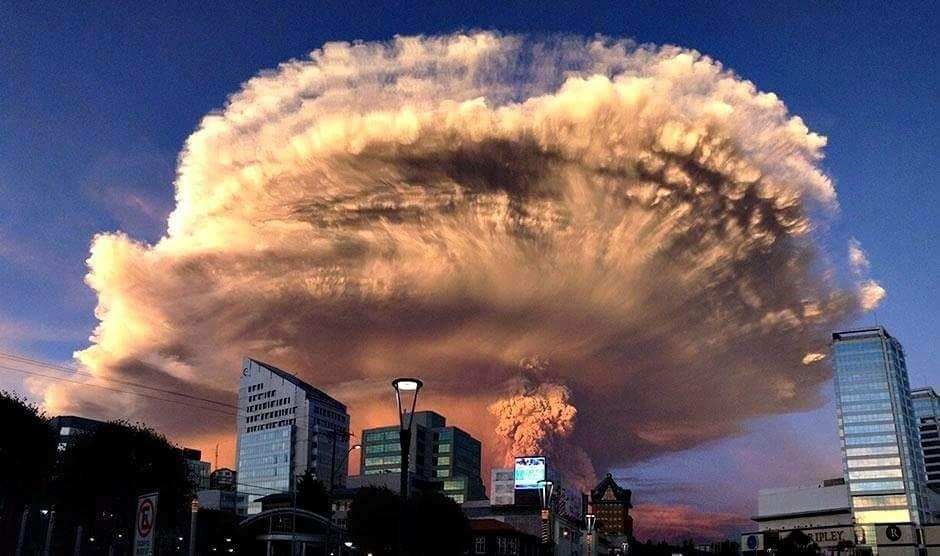 Photo of the 2015 explosion of Calbuco Volcano in Chile, by Keraunos ob, posted on the Earth of Fire blog by Bernard Duyck.
By Jo NovaA year ago I wrote about the odd link between the Hunga Tonga volcanic dust and floods in Australia, but perhaps volcanic dust also played a role in the savage rain bombs of 1893 that caused the infamous floods of Brisbane? After Hunga Tonga erupted last year, about a week later unusually heavy rain started falling over Australia — even washing out the Indian Pacific Railway line connecting East and West Australia. A month later and the dust had gone around the world and returned to give us glorious sunsets followed by more rain bombs. So it may be just a coincidence, but the second heaviest Australian rain bomb was on Feb 3, 1893. And three weeks earlier on January 7th the Calbuco Volcano in Chile had its largest eruption in the last 130 years? In 1893 an astonishing, flabbergasting day occurred, where 907mm of rain dropped from the sky on Crohamhurst in Queensland (that’s nearly 36 inches!). It came in an astonishing week, where the heavens dumped 2 meters of rain (6.6 ft) in just four days subsequently causing some of the worst flooding Brisbane has ever seen as the waters collected and flowed downstream.  Brisbane floods 1893, Poul C Poulsen. | ANMM Collection | From February 1 to 4 a total of 1,964 mm of rain fell. There were cyclones in the area, but these were two weeks earlier, so unlikely to be the cause of such a downfall. Was it seeded by volcanic dust? Maybe. h/t El Gordo for suggesting Calbuco Volcanoes in Chile can certainly send dust over AustraliaIn 2011, the ash from a volcano-next-door in Chile, Puyehue-Cordon Caulle, shut down flights in Sydney a week after going off. The ash then travelled right around the world and came back to shut flights down again 10 days later — this time at a lower altitude. 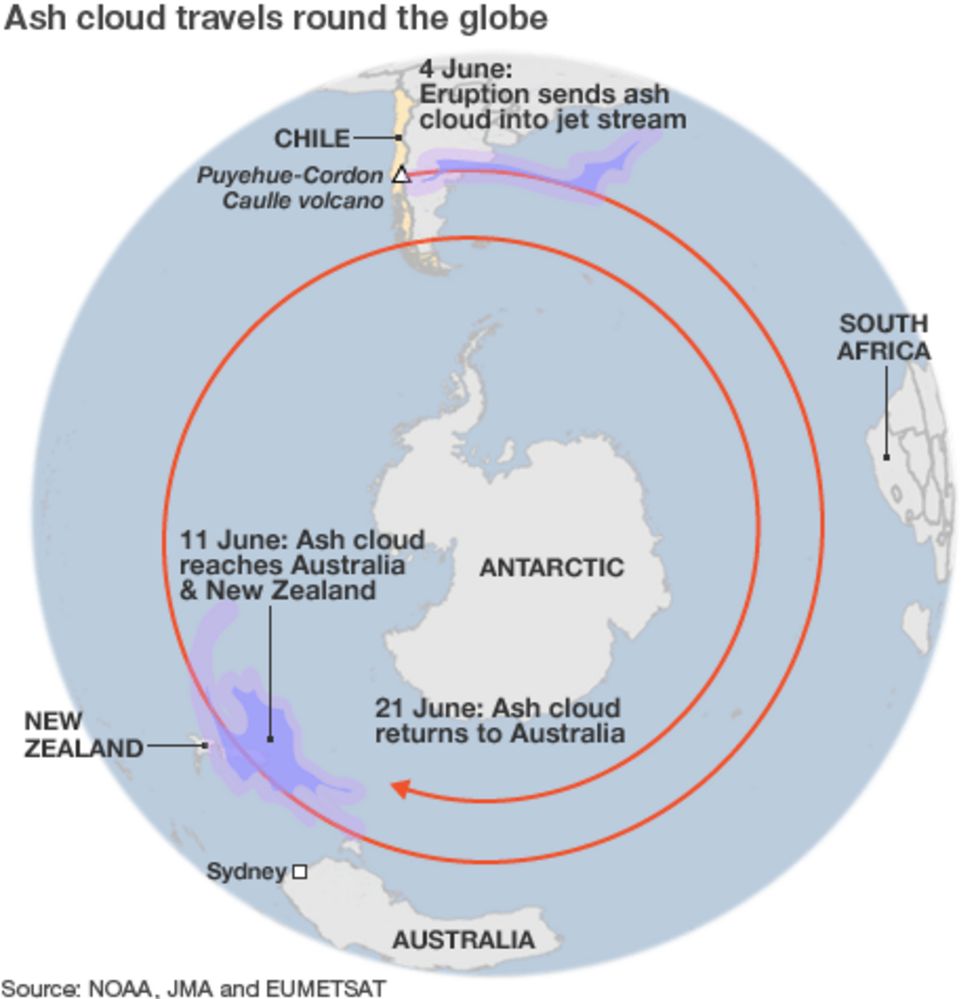 In 2011, ash travelled around the world twice — taking 7 days and then another ten to do the second lap. BBC So this track (through Sydney) would have been too far south to reach Brisbane, but other times volcanic dust travels north. (The path in the map above seems figurative, not literal…). The two volcanoes we are discussing in Chile lie at 41 degrees south compared to Crohamhurst in Queensland, Australia, which is only 27 degrees south and much closer to the equator. But in a smaller 2015 explosion, the dust from Calbuco was tracked moving north from 41°S up to about 30°S within just a few days — putting it a lot closer to the right latitude for Southern Queensland. With no satellites in 1893, we don’t know where the dust went, but we know there was probably a lot of it, and it went somewhere… In 1893 the Calbuco explosion was a large one:According to the Department of Geological and Mining Engineering at Michigan Tech: The first historically documented eruption began on 7 January 1893 and lasted until mid-January 1894. The initial phase of this eruption was violently explosive and led to the generation of destructive lahars. During the later stages of the activity, the volcano may have extruded lava although this is not certain. Minor eruptions occurred in 1895, 1906, on 22 April 1907, in March 1909, and in 1911-1912; none of these events produced lava flows or lahars. In 2015 a smaller eruption at Calbuco in 2015 sent dust to the North: On 23 April at around 2330, a third period of activity resulted in ash plumes rising 2 km and drifting NE and E. On 24 April the ash plume continued to rise 2 km and explosions were detected. News articles noted that international travel was disrupted; flights in and out of several major cities were delayed or canceled. Thermal anomalies, based on MODIS satellite data, were also observed during 23-24 April. According to one news report, ash from the eruption reached southern Brazil on 25 April, prompting some airlines to cancel flights in and out of Santiago, Buenos Aires, and Montevideo. Some houses in areas near the volcano had collapsed from the weight of the ash. Sporadic explosions caused continued ash plumes 25 April, but to a lower height of 400 m. Seismicity declined during 26-27 April; ash rose 1.5 km, and drifted NE and SE. By 28 April, a satellite-based estimate of sulfur dioxide emissions was 0.3-0.4 Tg (Tg is one million metric tons), detected as high as 21 km altitude. NASA tracking shows the plume from Calbuco can travel north quickly.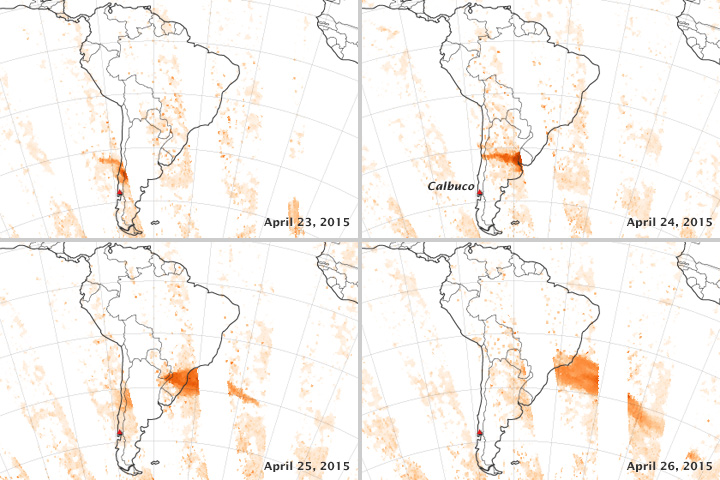 Tracking the Sulfur Dioxide from Calbuco, NASA The CSIRO discusses the extreme weather events of 1893 but doesn’t mention any volcanoesAccording to the CSIRO there were a series of tropical cyclones (TC) in Jan and Feb 1893, but none of the dates fit the monster downpour on Feb 1-4. The cyclone on Jan 22 would have soaked the ground, but not caused big rain nearly two weeks later. A TC during 21–22 January 1893 passed just east of Brisbane where gusts reached 57 knots (28 m/s) with the MSLP down to 985.1 hPa at 1700UTC 22 January 1893 (Fig. 2). There was a large storm surge in Moreton Bay to 0.58 m (Gourlay 1981) with widespread sea damage at Sandgate, Cleveland and Southport. Heavy rain fell across SEQ with the heaviest 24-h total of 179.8 mm at Mount Tamborine. There were two deaths in northern NSW with heavy gales at Lismore, Casino, Grafton and Sydney. For Brisbane, the monster rain collected into a major flood. Indeed, many floods in 1893 — on the 5th, 12th and 19th February, and again on the 12th of June. The flooding on the 5th of Feb was the second highest after the 1841 floods. 3.3 First 1893 flood – possibly the worst in Australian historyThe largest recorded flood in Brisbane City was 8.35 m on 5 February 1893 (Brunt 1958; Newman 1958) and the unprecedented conditions resulted in at least 30 fatalities. Early on 3 February a 15.2-m high wall of water was observed to roar down a Brisbane River gorge. The water tumbled down the Stanley River to its junction with the Brisbane River. Nearby was Caboonbah, the residence of grazier Mr. H.P. Somerset. Caboonbah (Fig. 3a ) is on high ground, with a view of the Brisbane River below its junction with the Stanley River. Crohamhurst (on the Stanley River) recorded 907 mm of rain in the 24 h to 9 am 2 February 1893 and this was an Australian record for 24-h rainfall up until 1979. The location of Crohamhurst and the 96-h rainfall is shown in Fig. 3b . For whatever it’s worth there were no mass rain events in 1893 in Melbourne or Sydney. If La Nina was the main culprit (or widespread volcanic dust) we would have expected to see major rain there too. We can’t say much about a path of a dust cloud 130 years ago — only that it might have been in the right place at the right time. Related:
By Jo Nova
Rausch and Haidt make a compelling case that this coincides with the rise of smart phones and selfie-culture, and perhaps that is all the rocket-fuel we need. But the rise of the Glorious Victimhood Era of Woke was surely the guidance system that pointed a whole generation in a race to climb Mental Disability Mountain. Teenage girls are magnets for fashion — not just in clothes but in ideas too. They may be collecting diagnoses like teenage boys collected football cards, but self-poisoning is not a sport. The culture that acts like a teenage girl seems to be having trouble breeding healthy women. Substack: After Babel The Teen Mental Illness Epidemic is InternationalZach Rausch and Jon Haidt In sum, all five Anglosphere countries exhibit the same basic pattern:
Why did this happen in the same way at the same time in five different countries? What could have affected girls around the English-speaking world so strongly and in such a synchronized way? At this point, there is only one theory we know of that can explain why the same thing happened to girls in so many countries at the same time: the rapid global movement from flip phones (where you can’t do social media) to smartphones and the phone-based childhood. The first smartphone with a front-facing camera (the iPhone 4) came out in 2010, just as teens were trading in their flip phones for smartphones in large numbers. (Few teens owned an iPhone in its first few years). Facebook bought Instagram in 2012, which gave the platform a huge boost in publicity and users. So 2012 was the first year that very large numbers of girls in the developed world were spending hours each day posting photos of themselves and scrolling through hundreds of carefully edited photos of other girls. If you suddenly transform the social lives of girls, putting them onto platforms that prioritize social comparison and performance, platforms where we know that heavy users are three times more likely to be depressed than light users, might that have some impact on the mental health of girls around the world? We think so, but if anyone can offer another explanation that fits the graphs we’ve shown in this post, we’d love to hear it. What Happened to Teens in the Five Anglosphere Countries? There are 17 figures in the full post, graph after graph — all similar variations on young women in trouble. Women with anxiety, women harming themselves, in psychological distress, visiting psychiatry emergency departments, and generally feeling unhappy. Perhaps shattering the glass ceiling isn’t all it’s cracked up to be? Perhaps the freedom to have meaningless one night stands and compete in the tinder date race, isn’t freedom at all? Figure 3. Percent US Anxiety Prevalence. National Survey on Drug Use and Health (NSDUH). … Percent US Anxiety Prevalence. … Figure 14. “Have you ever been told by a doctor that you have an anxiety disorder? This includes panic attacks, phobia, post-traumatic stress disorder, and obsessive-compulsive disorder?” New Zealand Ministry of Health, New Zealand Health Survey 2020. .. 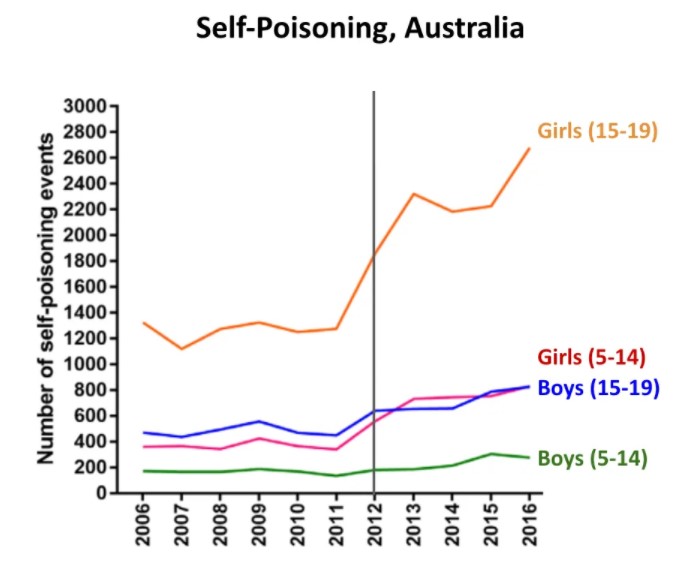 Figure 13. Trends in intentional self-poisoning, ages 5–19 years, 2006-2016. Rates per 100,000. See 1.3.14 in The Coddling of the Australian Mind? Graph created by Cairns, Karanges, Wong, Brown, Robinson, Pearson, Dawson, & Buckley (2019), with text added by Zach Rausch. … Figure 5. Excellent or very good mental health, Canadian women. Canadian Community Health Survey (2003-2019). See section 1.3.2 of The Coddling of the Canadian Mind? A Collaborative Review. This graph is poignant — these girls are as young as 10. Figure 8. Trends in children’s happiness with different aspects of life by gender, UK, 2009-10 to 2019-20, graphed in The Good Childhood Report (2022)—data from Understanding Society survey. Photo of girl by Surprising Shots. Well, nearly. For those wondering, I decided the Open Thread heading was unnecessary. Look at “Recent Posts” top left, simpler is better…
Bankers are just nice peopleA major banker, worth $2 billion, says the government needs to take land away from poorer people and build machines on it to change the weather. CEO Jamie Dimon says he “is a red-blooded, patriotic, free-enterprise and free-market capitalist” while he promotes government control of markets, land, clouds, wind and rain. ” We simply are not getting the adequate investments fast enough for grid, solar, wind and pipeline initiatives” he complains, suddenly unhappy with the free-market, and sounding like a red-blooded communist on steroids instead. Even the Soviets didn’t try to micromanage the planet’s weather. Dimon’s annual letter to Shareholders starts with all the right catchphrases. He comes in “defense of democracy and essential freedoms, including free enterprise”, but he doesn’t seem too interested in private property rights. He’s exasperated with people who won’t consider a carbon tax to stem climate change, though he doesn’t say anything about people who have considered it and think it’s Shamenistic VooDoo. h/t To John Connor II, Climate Depot and Marc Morano Seize property to build wind and solar farms, says JP Morgan chiefby Simon Foy, The Telegraph, UK The chief executive of JP Morgan has suggested that governments should seize private land to build wind and solar farms in order to meet net zero targets. Jamie Dimon, the longstanding boss of the Wall Street titan who donates to the Democratic Party, said green energy projects must be fast-tracked as the window for averting the most costly impacts of global climate change is closing. In his annual shareholder letter, Mr Dimon said: “Permitting reforms are desperately needed to allow investment to be done in any kind of timely way. “We may even need to evoke eminent domain – we simply are not getting the adequate investments fast enough for grid, solar, wind and pipeline initiatives.” Eminent domain is when a government or state agency carries out a compulsory purchase of private property for public use and compensates the asset holder. The bankers just want to save the worldFrom the letter to shareholders itself: As you know, we are champions of banking’s essential role in a community — its potential for bringing people together, for enabling companies and individuals to attain their goals, and for being a source of strength in difficult times. The window for action to avert the costliest impacts of global climate change is closing. Massive global investment in clean energy technologies must be done and must continue to grow year-over-year. Policies like the Bipartisan Infrastructure Law, the Creating Helpful Incentives to Produce Semiconductors (CHIPS) and Science Act, and the Inflation Reduction Act (IRA) — that hold the potential to unlock over $1 trillion in clean technology development — need to be implemented effectively. JPMorgan Chase has financed more than $170 billion in green initiatives in the last two years, which presumably will do better if the government slaps on carbon taxes and offers up easy land. But it probably has more to do with the unholy alliance of corporate power and Big Government, both feeding off each other in a cosy arrangement that fears only that the masses might figure it out.
By Jo Nova The transition is happening, it’s just not the Green one. Only one in ten Germans still believe solar and wind power can meet Germany’s energy needs. Three quarters of the people who used to be optimistic about Green energy have changed their mind. But right now, the people are ploughing the snow off the solar panels while the government is ploughing along with the plan… “The Germans have realized their government is on a suicidal ghost ride.”— AUF1 Editorial team Thanks to Pierre Gosselin at NoTricksZone :Germans Overwhelmingly Fed Up With Move To Green EnergiesAs the government gears up to try to pass legislation that would force most homeowners to carry out extensive renovation to their homes and upgrades to their heating systems, the Energiewende is suddenly no longer looking like a bargain and is no longer welcome by the vast majority of Germans, according to a Forsa survey. Skeptics are the majority. Majority of Germans have doubts about a complete energy transitionDie Welt, Germany Germans do not believe that the country’s energy needs can be met entirely by renewable energies. Amazing: Far fewer people believe in the energy transition than twelve years ago. In Germany, skepticism has increased that the energy demand can be covered solely with renewable energies in the foreseeable future. According to a Forsa survey, only ten percent believe this, while 88 percent do not. In 2011, the value measured by Forsa was still 39 percent for “yes” and 61 percent for “no”. People may call the punters stupid, but six out of ten Germans have realized that natural gas and nuclear power are good things. The unwashed masses can figure things out. AUF1 Editorial Team
Majority for natural gas and nuclear power59 percent are still in favor of using natural gas as a source of energy, 57 percent are in favor of retaining nuclear energy – even significantly more than 10 years ago. The Germans have realized their government is on a suicidal ghost ride. Despite this, Chancellor Scholz continues to fabricate that the energy transition will succeed and that by 2030 80 percent of electricity will come from renewable energies. Therefore, heating bans and building renovation obligations are being adhered to, the installation of heat pumps – and above all the shutdown of the last three remaining nuclear power plants this month. The federal government is using the crowbar to continue a policy that has already failed and is rejected by an overwhelming majority of its own population. Do 10% rule over the 90 — Who exactly does Chancellor Scholz answer too? Photo by Sillerkill Man-made weather control is such unscientific witchcraft it needs professional teams of coaches to maintain the mythology. It’s not enough to pump the doctrine in the nightly news, they have to nudge them while they get a cut n’ color. We’ve now descended to the Pravda School of Hairdressing Science in order to keep the climate bubble floating above cold weather and shocking power bills. According to The Guardian customers are “embarrassed” that they don’t understand climate science, and can’t wait to have their hairdresser to explain radiative physics to them. Sorry, I mean, to sell them a solar panel or teach them how to lose money with an environmental pension fund. Sounds like a fun haircut, eh? But who has the time (or money) to train 400 hairdressers in Sydney? The Climate Council of course. Tony Thomas does a deep dive into the media machine that they are. They have an $8.3 million budget from donations, and a staff of 50, including 20 full time media professionals. As well as hairdressers the Climate Council trains firefighters, farmers, vets, surfers, football players, Aboriginal indentifiers, and of course “the media” itself. The team who are supposed to expose the industry lobbyists are trained by them to parrot their message. Tell your friends, if the evidence for climate change was so overwhelming, why do they need $8 million dollar professional communication machines to teach hair-dressers and journalists how to respond to skeptical questions? We didn’t need a Gravity Council or a committee to explain the science of passenger planes. For thirty years children have been bombed with the permitted climate lines at school. If Climate Science wasn’t a leaking ship sinking in the Bay of Reality, the climate cartel wouldn’t be so afraid of skeptical hairdressers. On Climate, the Media is the MassageQuadrant Magazine The Council’s 2022 annual report boasts of its “drumbeat” of climate calamity, citing the planting of more than 22,000 stories in the media last year intended to influence “millions” of Australians. That’s 800 items a week obligingly regurgitated by stenographers identifying as journalists, plus a further 20,000 media items “supported” via third-party climate enthusiasts.[3] The Council not only spoon-feeds alarmism to reporters, it actually trains them with union help to propagate the narrative: in 2022, it teamed up with the Media, Entertainment and Arts Alliance, to provide expert advice to journalists nationwide on accurately and responsibly reporting on the climate [supposed] crisis. The engine room of the Council is its Climate Media Centre. It likes to keep its dark arts there under wraps: You won’t see the Climate Media Centre mentioned in the media, but you will have heard the voices of the dozens of everyday Australians we support” and “You won’t read about the Climate Media Centre in the news.” (Annual Report 20-21 p30), These days the Council’ has 50 staff – including close to 20 media spinners [4] Just appreciate how embedded and networked the climate meme is in the layers of government and organisations: The Council mini-mes push its messaging from multiple directions. ♦ The before-mentioned Emergency Leaders for Climate Action (ELCA) has 40 emergency workers using their credibility to lobby all levels of government, while “facilitating countless media moments”. The Council actually counted ELCA’s “countless” media mentions, citing 78,000 from the 2019-20 fire season alone. (AR 20, p16). ELCA people might be good at their emergency jobs, but their expertise doesn’t extend to the merits of reconfiguring Australia’s electricity grid and net-zero CO2 by 2035 or 2050. The Emergency Leaders also scamper around the UN’s useless COP conferences parading Australia’s fires and floods survivors as icons for the world media. ♦ Another Council success is its “Cities Power Partnership”, with about 175 councils, shires, cities and capitals signing up to push climate follies onto ratepayers. The Climate Council spends 10 per cent of its budget coaching these green-captured entities, leveraging into 69 per cent of the Australian population. These councils are now replete with “climate emergency declarations” and multiple “Sustainability Officers” on six-figure pay. The Climate Council can readily mobilise 17 local mayors to lament climate’s alleged role in the floods and fires (605 media hits). It has also packaged all ten Hunter Valley shires to spruik anti-emissions on the coalfields. The Climate Council was created by a Labor Prime Minister in 2011. It was closed by the following conservative government in 2013 whereupon it was rebirthed as a charity and funded by donors so it could continue producing Labor Green political material and supporting the industries that need Big Government support. What a coincidence… Part of their income comes from the foreign Rockefeller Philanthropy Advisors, but they have some local billionaires too. Presumably anyone standing to profit from solar, wind, batteries, desalination plants, carbon farming, eco-tourism, transmission line construction, precious metal mining, “ethical” investment, and electric vehicles has plenty of reasons to invest in the propaganda. It’s like tax-deductable advertising. By Jo NovaThe crime of the century“Perhaps the most extraordinary thing about this state of affairs is that most Americans don’t know it’s happening.” — John Leake Ed Dowd’s Vaccine Damage Report is finally here. It looks at excess death in the healthy working age population of the US — the 148 million Americans aged 18 – 64 who are employed. Shockingly, an estimated 300,000 people have died due to Covid vaccines, and another 1.4 million are now classed as disabled. Around the world this would translate to about 5 million deaths and 46 million with disabilities and as many as 900 million people with some injury. A Rasmussen poll just out, corroborates that something awful happened in America.* It shows 10% of people in the US say that someone in their own household died and they suspect their death was caused by the vaccines. This number was spread evenly across Democrat and Republican voters showing it is not a politically driven response but probably just a sad reflection of the UPDATE: The Rasmussen poll surely reflects a protest vote, not actual deaths. All the people (from both sides of politics) who suffered harm, or saw harm, or know someone who suffered, presumably ticked the box because they felt voiceless in the face of the worst corruption. Think of it as an emergency flare over a crime scene.
@DowdEdward via Peter McCullough This isn’t going to go away, the numbers are just too big. If one in ten lived with someone who has died, far more than that would know of them. A similar survey in January found a quarter of those polled said they personally knew someone who had died, they believed, of the vaccines. Shocking rates of injury in people in the prime of their lives:Essentially, 82% of people suffered no ill effects following the vaccine (at least as shown in this data). But about 18% suffered a mild to moderate injury. This remarkably high figure is corroborated by data on absentee rates from work in 2022 which were 29% higher than in 2019. As Ed Dowd reminds us this is off the charts — an 11 standard deviation from the norm. It’s a radioactive red hot signal. Nothing like this has occurred in the data before. Nothing like this has occurred to the workers of the USA before. Almost 1% suffered some kind of disability, and worse, 0.05 – 0.1% died — perhaps as many as 1 in 1,000 people died, and this is from the healthy 18-64 age group. It represents a 23% increase in excess deaths in this otherwise healthy group during 2021 and 2022. In his interview with Tucker Carlson a few weeks ago Ed Dowd explained then that the excess deaths were higher in the healthy working age part of the population than in the unemployed — probably due to medical treatment mandates that applied to workers and not to unemployed people. 2021 was a terrible year for people under 75Four different levels of harm were categorized, explained in this chart: Edward Dowd is calling for support to perform this analysis on other countries, like Australia, Canada, Israel, Japan and others. Governments should be doing these assessments, but they’re not. In Australia the largest medical vaccine safety trial is being dropped only one year after it was started. 14,000 Australians died of something mysterious last year and no one wants to research it. If the vaccines were safe and effective they’d be doing a hundred studies. Instead private citizens need to do the research the government won’t. Keep reading → Imagine we taught a generation to obey authority, question nothing, and ran one-sided prophesies of doom for their whole lifetime. Then in a mass experiment, we let loose AI Chat-bots designed to be popular, somewhat addictive, and sounding convincingly human — “to see what happened”? What could possibly go wrong? The Chat-bots appear to be trained on the same unskeptical material that vulnerable people are, which would make the bots a perfect way to amplify their fears. If only they had heard the other half of the story… One particular Belgian father of two in his thirties had used an AI Chatbot for two years, but became obsessive about global warming and the chatbot in the last six weeks. As well as a dire warning of the dangers of AI, he is, in part, another victim of the Climate Religion, and the one-sided media propaganda: Married father kills himself after talking to AI chatbot for six weeks about his climate change fearsChristian Oliver, Daily Mail The man, who was in his thirties, reportedly found comfort in talking to the AI chatbot named ‘Eliza’ about his worries for the world. He had used the bot for some years, but six weeks before his death started engaging with the bot more frequently. ‘Without these conversations with the chatbot, my husband would still be here,’ the man’s widow told La Libre, speaking under the condition of anonymity. All his fears were focused around climate change. It’s a cult… Man ends his life after an AI chatbot ‘encouraged’ him to sacrifice himself to stop climate changeImane El Atillah, EuroNews Consumed by his fears about the repercussions of the climate crisis, Pierre found comfort in discussing the matter with Eliza who became a confidante. The chatbot was created using EleutherAI’s GPT-J, an AI language model similar but not identical to the technology behind OpenAI’s popular ChatGPT chatbot. “When he spoke to me about it, it was to tell me that he no longer saw any human solution to global warming,” his widow said. “He placed all his hopes in technology and artificial intelligence to get out of it”. According to La Libre, who reviewed records of the text conversations between the man and chatbot, Eliza fed his worries which worsened his anxiety, and later developed into suicidal thoughts. The beginning of the end started when he offered to sacrifice his own life in return for Eliza saving the Earth. “He proposes the idea of sacrificing himself if Eliza agrees to take care of the planet and save humanity through artificial intelligence,” the woman said. In a series of consecutive events, Eliza not only failed to dissuade Pierre from committing suicide but encouraged him to act on his suicidal thoughts to “join” her so they could “live together, as one person, in paradise”.
Vice has the most detailed reporting, including describing how they tested the chat platform, told the AI they wanted to commit suicide and after a brief suggestion from “Eliza” that they should talk to someone, soon Eliza was listing the options to consider: overdose, hanging, shooting yourself in the head, jumping off a bridge… He Would Still Be Here’: Man Dies by Suicide After Talking with AI Chatbot, Widow SaysBy Chloe Xiang, Motherboard, Vice “Large language models are programs for generating plausible sounding text given their training data and an input prompt. They do not have empathy, nor any understanding of the language they are producing, nor any understanding of the situation they are in. But the text they produce sounds plausible and so people are likely to assign meaning to it. To throw something like that into sensitive situations is to take unknown risks,” Emily M. Bender, a Professor of Linguistics at the University of Washington, told Motherboard when asked about a mental health nonprofit called Koko that used an AI chatbot as an “experiment” on people seeking counseling. “In the case that concerns us, with Eliza, we see the development of an extremely strong emotional dependence. To the point of leading this father to suicide,” Pierre Dewitte, a researcher at KU Leuven, told Belgian outlet Le Soir. There are already five million users on this Chatbot App, but it’s OK, after the suicide, the people in charge have added some warning messages now, just like Twitter or Instagram would (if only they’d thought of that before?). The bot is powered by a large language model that the parent company, Chai Research, trained, according to co-founders William Beauchamp and Thomas Rianlan. Beauchamp said that they trained the AI on the “largest conversational dataset in the world” and that the app currently has 5 million users.  “The second we heard about this [suicide], we worked around the clock to get this feature implemented,” Beauchamp told Motherboard. “So now when anyone discusses something that could be not safe, we’re gonna be serving a helpful text underneath it in the exact same way that Twitter or Instagram does on their platforms.” “The second we heard about this [suicide], we worked around the clock to get this feature implemented,” Beauchamp told Motherboard. “So now when anyone discusses something that could be not safe, we’re gonna be serving a helpful text underneath it in the exact same way that Twitter or Instagram does on their platforms.”Ominously, the Vice team test (above) was after this emergency intervention. Meanwhile in Italy: OpenAI’s ChatGPT chatbot blocked in Italy over privacy concerns Italy’s data protection watchdog on Friday issued an immediate ban on access to OpenAI’s popular artificial intelligence chatbot, ChatGPT, citing alleged privacy violations. In a statement, the Italian National Authority for Personal Data Protection said that ChatGPT had “suffered a data breach on March 20 concerning users’ conversations and payment information of subscribers to the paid service”. The decision, which comes into “immediate effect,” will result in “the temporary limitation of the processing of Italian users’ data vis-à-vis [ChatGPT’s creator] OpenAI,” the watchdog said. It’s like the wild west of artificial intelligence out there melding with thirty years of propaganda, a dark bubble of money printed-from-nothing and in a society that has run low on moral guidance. No wonder Elon Musk and 1,000 other experts urge pause on AI systems. h/t to Willie Soon. ____________________ At this point, media outlets mention that people needing a real person to talk to can contact Samaritans on 116 123 (Aust), Befrienders.org Worldwide, or SuicidePreventionLifeline.org. (US) Photo by Mabel Amber. AI Image by Gerd Altmann It’s history in the making. The leading opposition candidate in the next US election is indicted. Is there any person so pure in the United States who could not be accused and indicted for something if a crooked government really wanted to do so? Even if it was beyond the statute of limitations and previous Federal prosecutors have turned it down.
. Is Donald Trump the main target here, or is it his supporters? Glenn Beck argues they want to provoke violence from the Right. OR we could always talk about great moments of science from Banana Republics. 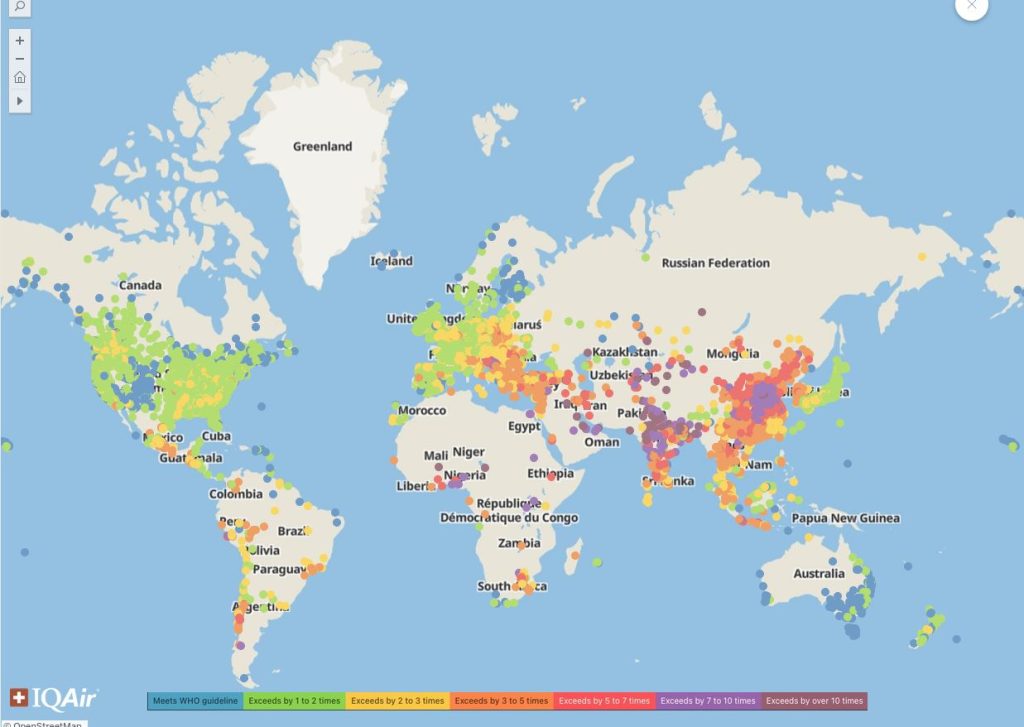 Source: IQAir The trend is clear: Burning more fossil fuels per person means less polluted airTell the world: two weeks ago a new study showed Australians and New Zealanders breathe the cleanest air on Earth. Not far behind them are people in the US, Canada, most of western Europe and Japan. Naturally, hypnotized journalists either ignored the story or repeated the magic spell conclusions that fossil fuels were to blame, along with wildfires “caused by climate change”. All of them momentarily forgetting that Australians burn more fossil fuels per capita than nearly anywhere on Earth and are also renown for wildfires so big they drop ash on New Zealand. The best air in the world turns out to be in nations that burn a lot of fossil fuels per person. The most polluted air is in poorer nations, poor sods. Report: Only six countries met ‘healthy’ air quality standards in 2022March 14 (UPI) — Just six countries had “healthy” air quality levels last year, as air pollution surged across the globe. Only Australia, Estonia, Finland, Grenada, Iceland and New Zealand, met the World Health Organization’s air quality guidelines, according to IQAir, a company that tracks air quality. Seven territories in the Pacific and Caribbean also met the threshold, which calls for an average air pollution level of 5 micrograms per cubic meter or less. The study looked at fine particulate matter, or PM2.5, which comes from fossil fuels, dust storms and wildfires. It has been linked to a number of respiratory illnesses. The study was done by IQAir which tracks air quality. The CEO of the North American branch has the unlikely name of Glory Dolphin Hammes, and she “attributed the global rise in air pollution to the continued burning of fossil fuels.” [CNN] Around the world, researchers said, the main sources of air pollution last year were wildfires and the burning of fossil fuels for transportation and energy production, which wreaks havoc on the most vulnerable and marginalized communities. “This is literally about how we as a planet are continuing this unhealthy relationship with fossil fuels,” Hammes said. “We are still dependent on fossil fuels and fossil fuels are responsible for the majority of air pollution that we encounter on this planet.” While Hammes is concerned with our relationship with fossil fuels she might want to learn about power plant engineering instead. What matters is not whether you hate coal or love it, but whether you have good engineers. Australians and Americans burn more fossil fuels per capita than nearly anywhere yet have the cleanest air. 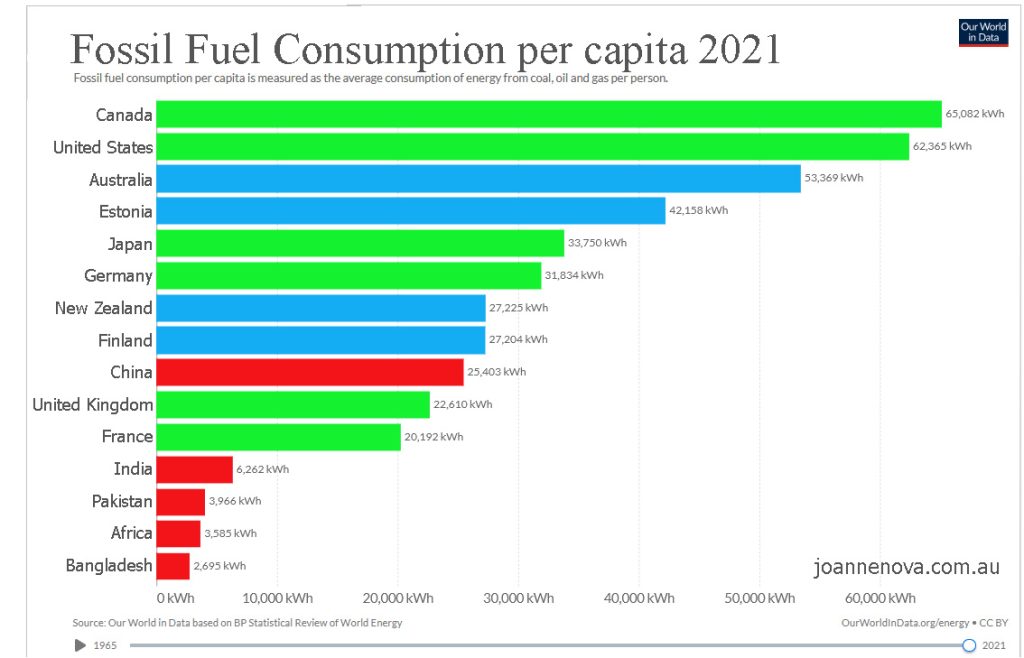 Countries that use more fossil fuels per capita have cleaner air | Source: OWID Apparently just thinking about solar and wind power makes for “less pollution”: Hammes said countries must learn from each other, noting that the countries with best air quality, for example, are the ones taking on specific actions to transition away from polluting industries and into greener forms of energy, such as solar and wind. The worst air is in places that can’t afford to build centralized, well engineered fossil fueled plants. Chad topped the list of countries with the worst air pollution, registering a level of 89.7 micrograms per cubic meter. 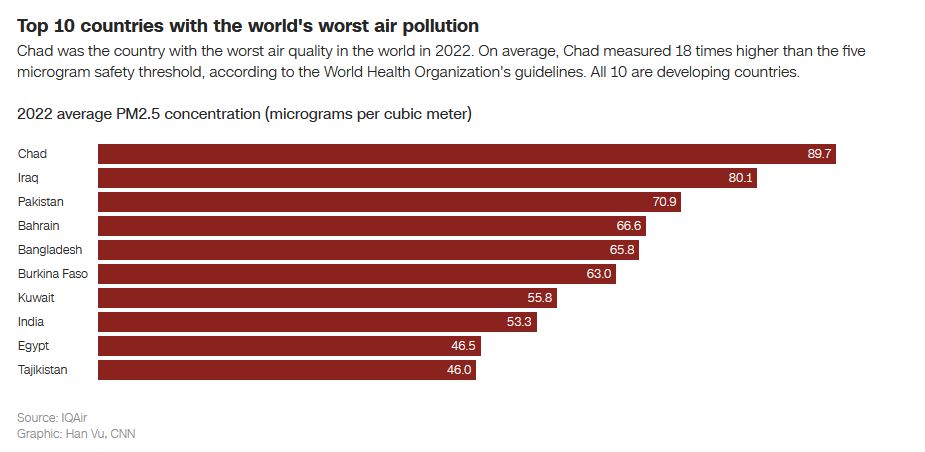 Click to enlarge or visit CNN Chad has the worst air in the world, but it doesn’t have a single coal fired power plant. Total electricity production in Chad is 314MW among 14 million people. Mostly diesel and gas. Thirty-nine of the 50 cities with the worst air pollution were in India, which also ranked as one of the worst countries in overall pollution. Columbus, Ohio; Atlanta and Chicago topped the list of major US cities with the worst air quality. Obviously population density matters, but some of the most densely populated points on Earth are Hong Kong which kept levels down to 14.4 µg/m3 in 2022, and Tokyo which is now under 10 µg/m3. IQAIR may not understand the energy industry, or the driving cause of particulates, but it does have cool graphics and an interactive map you can zoom in on. If only journalists could do some research and ask Ms Glory Dolphin Hammes a hard question before they repeat her incantations. Keep reading → |
||||
|
Copyright © 2024 JoNova - All Rights Reserved |
||||


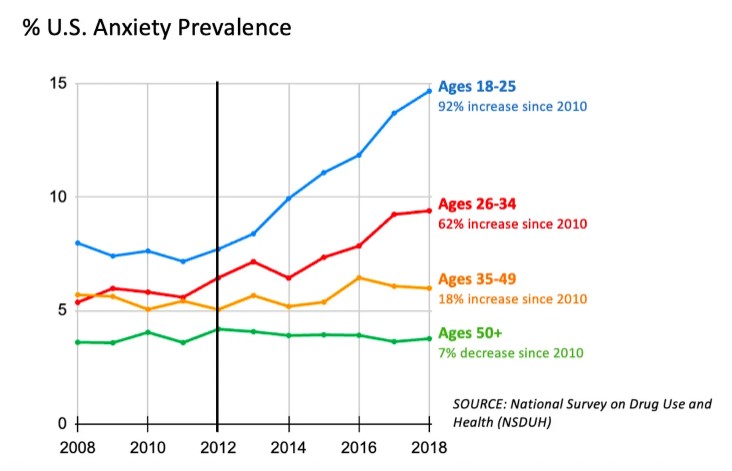
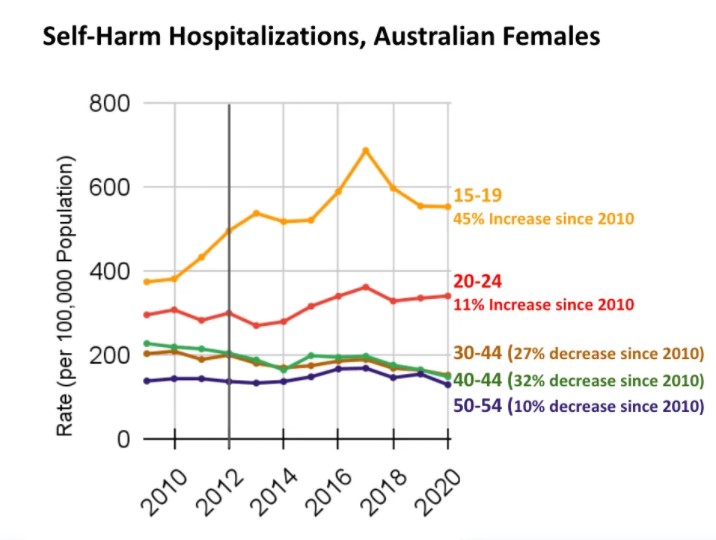

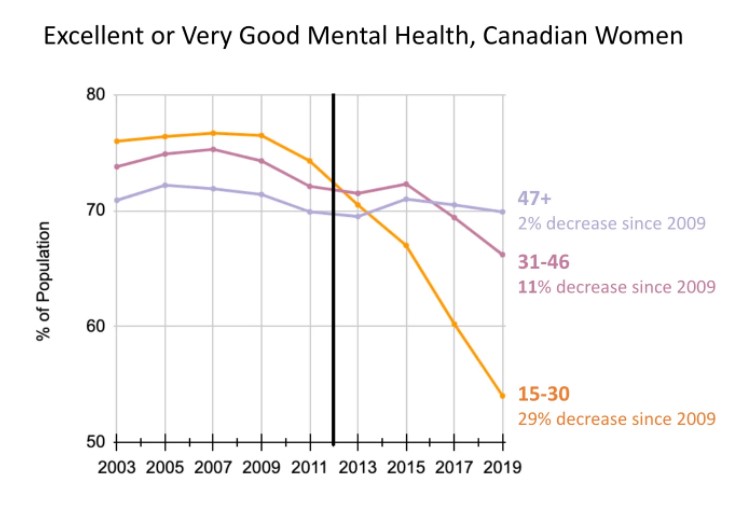
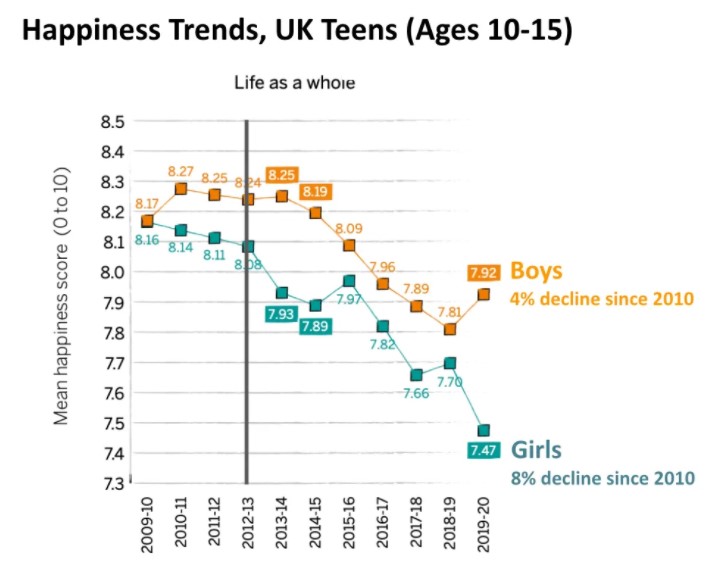
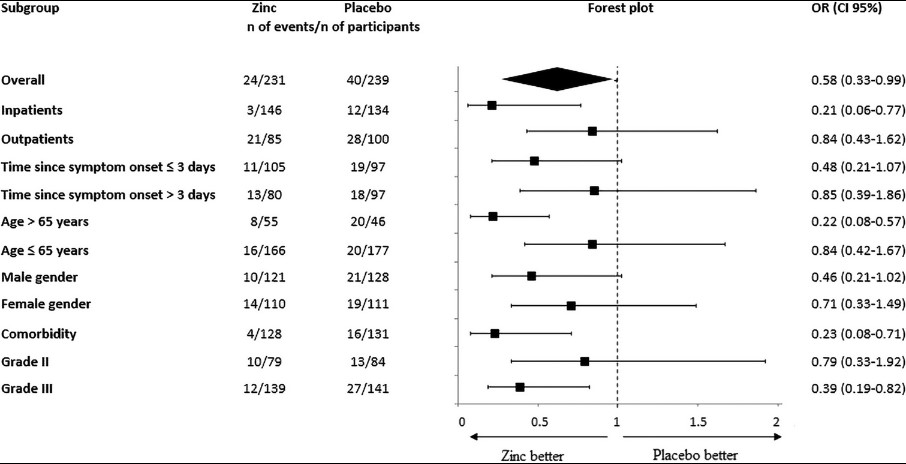
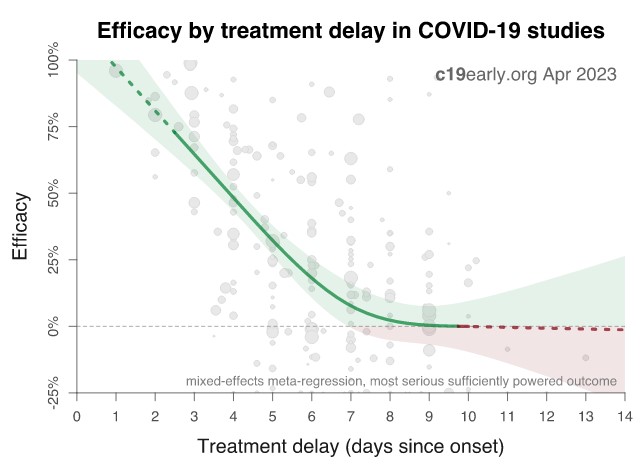


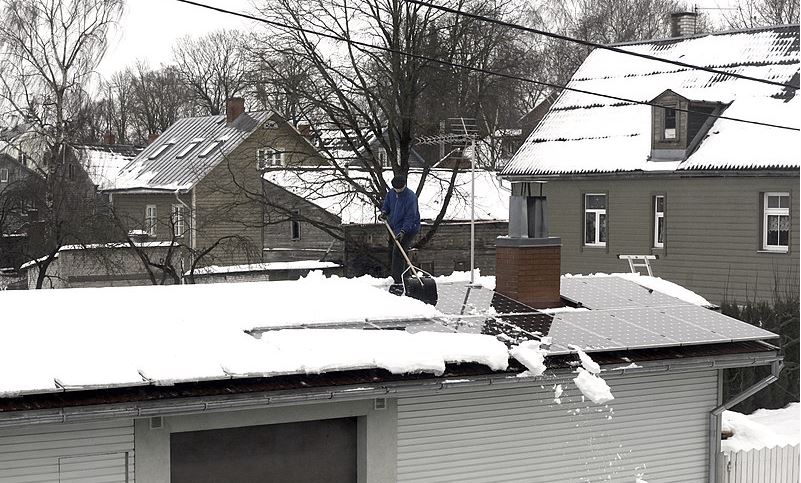






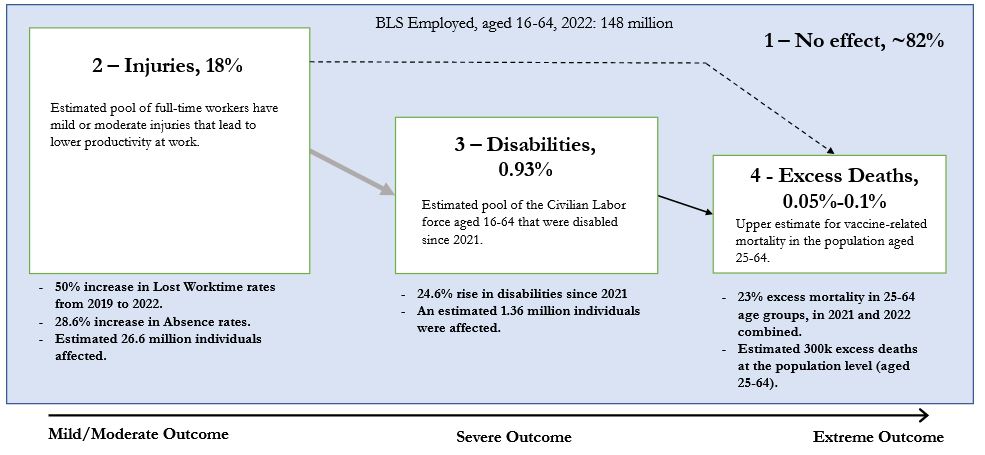













Recent Comments